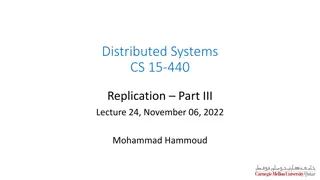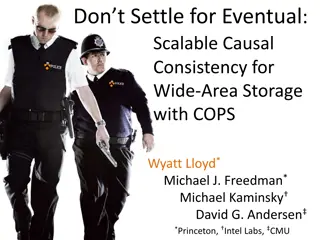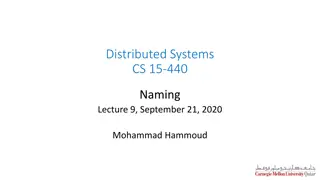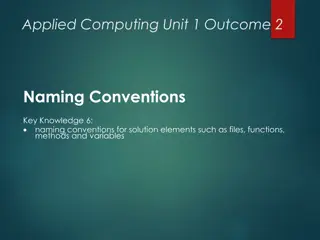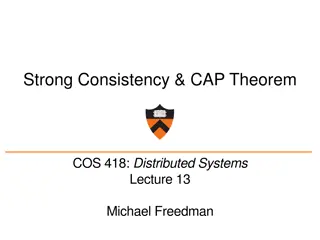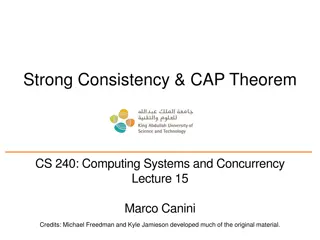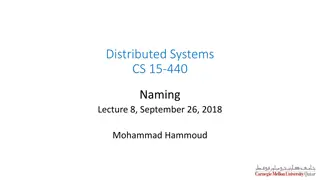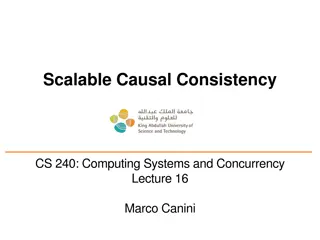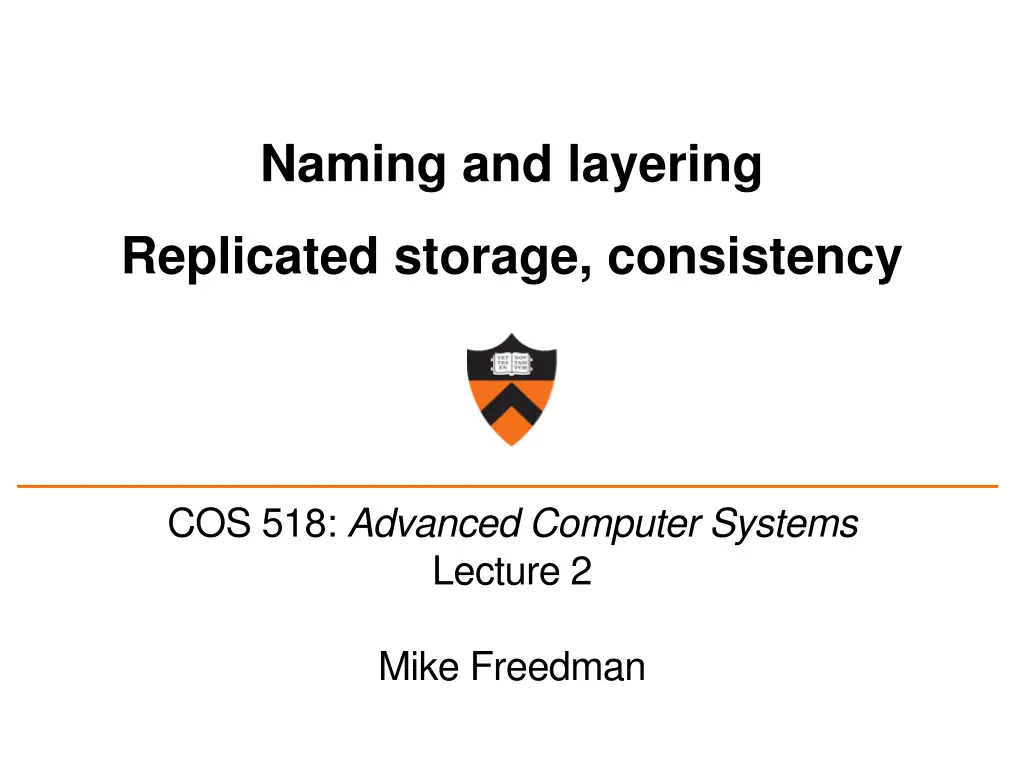
Advanced Computer Systems Lecture on Naming and Layering in Replicated Storage
Explore the concepts of naming and layering in replicated storage systems, discussing system components, potential name syntax, properties of naming, various types of names, and a high-level view of naming systems.
Download Presentation

Please find below an Image/Link to download the presentation.
The content on the website is provided AS IS for your information and personal use only. It may not be sold, licensed, or shared on other websites without obtaining consent from the author. If you encounter any issues during the download, it is possible that the publisher has removed the file from their server.
You are allowed to download the files provided on this website for personal or commercial use, subject to the condition that they are used lawfully. All files are the property of their respective owners.
The content on the website is provided AS IS for your information and personal use only. It may not be sold, licensed, or shared on other websites without obtaining consent from the author.
E N D
Presentation Transcript
Naming and layering Replicated storage, consistency COS 518: Advanced Computer Systems Lecture 2 Mike Freedman
Naming and system components Caller Callee How to design interface between components? Many interactions involve naming things Naming objects that caller asks calleeto manipulate Naming caller and calleetogether 2
Potential Name Syntax Human readable? If users interact with the names Fixed length? If equipment processes at high speed Large name space? If many nodes need unique names Hierarchical names? If the system is very large and/or federated Self-certifying? If preventing spoofing is important 3
Properties of Naming Enabling sharing in applications Multiple components or users can name a shared object. Without names, client-server interface pass entire object by value Retrieval Accessing same object later on, just by remembering name Indirection mechanism Component A knows about name N Interposition: can change what N refers to without changing A Hiding Hides impl. details, don t know where google.com located For security purposes, might only access resource if know name (e.g., dropbox or Google docs URL > knowledge gives access) 4
Names all around Registers: LD R0, 0x1234 IP addresses: 128.112.132.86 Host names: www.cs.princeton.edu Path names: /courses/archive/spring17/cos518/syllabus.html vs. syllabus.html .. (to parent directory) URLs: http://www.cs.princeton.edu/courses/archive/spring17/cos518/ Email addresses Function names: ls Phone numbers: 609-258-9169 vs. x8-9179 SSNs 5
High-level view of naming Set of possible names Set of possible values that names map to Lookup algorithm that translates name to value Optional context that affects the lookup algorithm 6
Helping to understand naming system Name syntax? Values? Context used to resolve name? Who supplies context? Global (context-free) or local names? 7
Different Kinds of Names Host names: www.cs.princeton.edu Mnemonic, variable-length, appreciated by humans Hierarchical, based on organizations IP addresses: 128.112.7.156 Numerical 32-bit address appreciated by routers Hierarchical, based on organizations and topology MAC addresses : 00-15-C5-49-04-A9 Numerical 48-bit address appreciated by adapters Non-hierarchical, unrelated to network topology 8
Hierarchical Assignment Processes Host names: www.cs.princeton.edu Domain: registrar for each top-level domain (eg, .edu) Host name: local administrator assigns to each host IP addresses: 128.112.7.156 Prefixes: ICANN, regional Internet registries, and ISPs Hosts: static configuration, or dynamic using DHCP MAC addresses: 00-15-C5-49-04-A9 Blocks: assigned to vendors by the IEEE Adapters: assigned by the vendor from its block 9
Case Study: Domain Name System (DNS) Computer science concepts underlying DNS Indirection: names in place of addresses Hierarchy: in names, addresses, and servers Caching: of mappings from names to/from addresses 10
Strawman Solution #1: Local File Original name to address mapping Flat namespace /etc/hosts SRI kept main copy Downloaded regularly Count of hosts was increasing: moving from a machine per domain to machine per user Many more downloads Many more updates 11
Strawman Solution #2: Central Server Central server One place where all mappings are stored All queries go to the central server Many practical problems Single point of failure High traffic volume Distant centralized database Single point of update Does not scale Need a distributed, hierarchical collection of servers 12
Domain Name System (DNS) Properties of DNS Hierarchical name space divided into zones Distributed over a collection of DNS servers Hierarchy of DNS servers Root servers Top-level domain (TLD) servers Authoritative DNS servers Performing the translations Local DNS servers and client resolvers 13
Reliability DNS servers are replicated Name service available if at least one replica is up Queries can be load balanced between replicas UDP used for queries Need reliability: must implement this on top of UDP Try alternate servers on timeout Exponential backoff when retrying same server Same identifier for all queries Don t care which server responds 14
Distributed Hierarchical Database unnamed root zw arpa uk com edu org ac generic domains country domains in- addr bar ac west east 12 cam foo my 34 usr my.east.bar.edu usr.cam.ac.uk 56
root DNS server for . DNS Queries 3 TLD DNS server for .edu 4 5 local DNS server dns.princeton.edu a.cs.princeton.edu 6 wants IP address for 2 7 www.umass.edu 9 8 local DNS server dns.cs.princeton.edu authoritative DNS server for umass.edu dns.umass.edu 1 10 Recursive vs. Iterative Queries requesting host a.cs.princeton.edu www.umass.edu 17
root DNS server for . DNS Queries 3 TLD DNS server for .edu DNS query latency: e.g., 1 second 4 5 6 Caching to reduce overhead and delay Small # of top-level servers, that change rarely Popular sites visited often 2 7 9 8 authoritative DNS server for umass.edu dns.umass.edu 1 10 Where to cache? Local DNS server Browser requesting host a.cs.princeton.edu www.umass.edu 18
DNS Cache Consistency Goal: Ensuring cached data is up to date DNS design considerations Cached data is read only Explicit invalidation would be expensive Server would need to keep track of all resolvers caching Avoiding stale information Responses include a time to live (TTL) field Delete the cached entry after TTL expires Perform negative caching (for dead links, misspellings) So failures quick and don t overload gTLD servers 19
Layering 20
Layering Partition the system Each layer solely relies on services from layer below Each layer solely exports services to layer above Interface between layers defines interaction Hides implementation details Layers can change without disturbing other layers
OSI Layering Model Open Systems Interconnection (OSI) Developed by International Organization for Standardization (OSI) in 1984 Seven layers Application Presentation Session Transport Internet Protocol (IP) Only five layers The functionalities of the missing layers (i.e., Presentation and Session) are provided by the Application layer Network Datalink Physical
Five Layers Summary Lower three layers implemented everywhere Top two layers implemented only at hosts Logically, layers interacts with peer s corresponding layer Application Application Transport Network Datalink Physical Transport Network Datalink Physical Network Datalink Physical Host A Router Host B
Physical Communication Communication goes down to physical network Then from network peer to peer Then up to relevant layer Application Application Transport Network Datalink Physical Transport Network Datalink Physical Network Datalink Physical Host A Router Host B
Layer model and headers Application Layer Application Layer Data Data Transport Layer Transport Layer Trans. Hdr. Trans. Hdr. Data Data Network Layer Network Layer Net. Hdr. Trans. Hdr. Net. Hdr. Trans. Hdr. Data Data Datalink Layer Datalink Layer Net. Hdr. Trans. Hdr. Net. Hdr. Trans. Hdr. Frame Hdr. Frame Hdr. Data Data Physical Layer Physical Layer 101010100110101110 101010100110101110
Drawbacks of Layering Layer N may duplicate layer N-1 functionality E.g., error recovery to retransmit lost data Layers may need same information E.g., timestamps, maximum transmission unit size Layering can hurt performance E.g., hiding details about what is really going on Some layers are not always cleanly separated Inter-layer dependencies for performance reasons Some dependencies in standards (header checksums) Headers start to get really big Sometimes header bytes >> actual content
Placing Network Functionality Hugely influential paper: End-to-End Arguments in System Design by Saltzer, Reed, and Clark ( 84) Sacred Text of the Internet Endless disputes about what it means Everyone cites it as supporting their position
Intro to fault tolerant + consistency 29
What is fault tolerance? Building reliable systems from unreliable components Three basic steps 1. Detecting errors: discovering presence of an error in a data value or control signal 2. Containing errors: limiting how far errors propagate 3. Masking errors: designing mechanisms to ensure system operates correctly despite error (+ possibly correct error) 30
Why is fault tolerance hard? Failures Propagate Say one bit in a DRAM fails it flips a bit in a memory address the kernel is writing to... ...causes big memory error elsewhere, or a kernel panic... ...program is running one of many distributed file system storage servers... ...a client can t read from FS, so it hangs 31
So what to do? 1. Do nothing: silently return the failure 2. Fail fast: detect the failure and report at interface Ethernet station jams medium on detecting collision 3. Fail safe: transform incorrect behavior or values into acceptable ones Failed traffic light controller switches to blinking-red 4. Mask the failure: operate despite failure Retry op for transient errors, use error-correcting code for bit flips, replicate data in multiple places 32
Masking failures We mask failures on one server via Atomic operations Logging and recovery In a distributed system with multiple servers, we might replicate some or all servers But if you give a mouse some replicated servers She s going to need to figure out how to keep the state of the servers consistent (immediately? eventually?) 33
Reasoning about fault tolerance This is hard! How do we design fault-tolerant systems? How do we know if we re successful? Often use properties that hold true for every possible execution We focus on safety and liveness properties 35
Safety Bad things don t happen No stopped or deadlocked states No error states Examples Mutual exclusion: two processes can t be in a critical section at the same time Bounded overtaking: if process 1 wants to enter a critical section, process 2 can enter at most once before process 1 36
Liveness Good things happen eventually Examples Starvation freedom: process 1 can eventually enter a critical section as long as process 2 terminates Eventual consistency: if a value in an application doesn t change, two servers will eventually agree on its value 37
Often a tradeoff Good and bad are application-specific Safety is very important in banking transactions Liveness is very important in social networking sites 38
Eventual consistency Def n: If no new updates to the object, eventually all accesses will return the last updated value Common: git, iPhone sync, Dropbox, Amazon Dynamo Why do people like eventual consistency? Fast read/write of local copy (no primary, no Paxos) Disconnected operation Challenges How do you discover other writes? How do you resolve conflicting writes? 40
Two prevailing styles of discovery Gossip pull ( anti-entropy ) A asks B for something it is trying to find Commonly used for management replicated data Resolve differences between DBs by comparing digests Gossip push ( rumor mongering ): A tells B something B doesn t know Gossip for multicasting Keep sending for bounded period of time: O (log n) Also used to compute aggregates Max, min, avg easy. Sum and count more difficult. Push-pull gossip Combines both : O(n log log n) msgs to spread in O(log n) time
Monday reading for everybody Conflict resolution in eventually consistent systems: Bayou + OT 42

